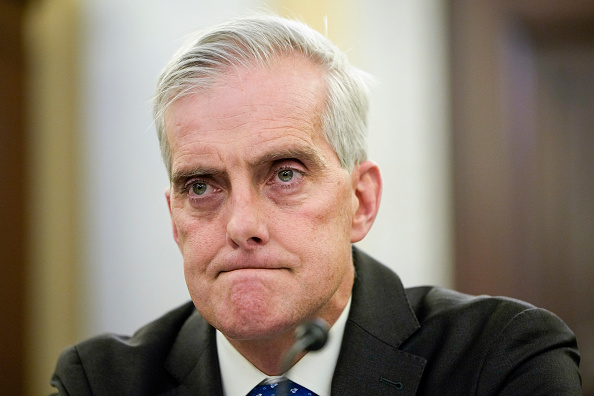The U.S. Department of Veterans Affairs (VA) spends one-third of its health care budget on community care, and could limit access to these non-VA providers, VA Secretary Denis McDonough stated at a U.S. Senate committee hearing on June 14.
The 2018 VA Maintaining Internal Systems and Strengthening Integrated Outside Networks (MISSION) Act allowed vets more access to community care by non-VA providers when wait times for an appointment at VA hospitals and clinics become too long. The MISSION Act specifies the circumstances under which vets can receive non-VA care.
More vets are seeking community care under the MISSION Act, says McDonough.
“[33 percent is] a high number, and that’s the highest number yet of the three years of the MISSION Act,” said McDonough. “Care overall, as you have seen in the budget, is growing. Care in the community as a portion of that is growing … My hunch is that we should change access standards.”
The Office of the Inspector General (OIG) found the VA presents flawed performance data to the public, despite reforms following news reports of negligent and physically abusive treatment of patients at VA hospitals in 2014.
Starting the Clock Later
The VA uses misleading methodology and incomplete data sets to calculate patient wait times, creating confusion about the health care needs of veterans and the department’s performance, states Inspector General Michael J. Missal, in a memorandum published on April 7.
“VHA [Veteran’s Health Administration] has sometimes presented wait times with different methodologies, using inconsistent start dates that affect the overall calculations without clearly and accurately presenting that information to the public,” wrote Missal.
The VA’s Access to Care website for patients logged wait times using the “create date”—when the appointment was booked—instead of the “request date,” when the appointment was scheduled, as required by federal statutes and regulations. This results in wait times appearing shorter, writes Missal.
“VHA has published wait time data based on start dates that are inconsistent with VHA policy and publicly stated methodologies, and the stated description of methodologies on its website may be misleading,” wrote Missal.
Obtaining services from the VA’s network of community care providers requires pre-authorization. Documents the Americans For Prosperity Foundation (AFPF) obtained through a Freedom of Information Act (FOIA) request in early 2022 show the VA created an additional layer of review after a veteran is found eligible for community care. The VA policy, which is not required by the MISSION Act, calls for “clinical review” to “determine if the requested services are clinically appropriate to be authorized for delivery in the community.”
No Community Care
Documents from a 2021 FOIA request by the Americans for Prosperity Foundation on behalf of Concerned Veterans for America (CVA) revealed the VA was creating confusion over data surrounding community care and actively discouraging veterans from seeking out non-VA benefits, CVA Deputy Director Russ Duerstine told Health Care News.
“Guidance being used by the VA discourages VA employees from offering to review eligibility for community care for veterans unless they ask for it themselves,” said Duerstine.
The VA provides responses to inquiries that are misleading, says Duerstine.
“The VA is actively providing sample scripts for employees to use when talking to veterans eligible for community care,” said Duerstine. “The VA’s script actively dissuades veterans from choosing community care by using inaccurate community wait time data and placing the expectation on the veteran to ensure their care is coordinated and to obtain their medical records.”
Veterans become eligible for community care after their wait for an appointment exceeds 20 days for primary care or 28 days for specialty care.
More Bureaucracy
The VA system is like the socialist Canadian health care system, says John C. Goodman, president of the Goodman Institute and co-publisher of Health Care News.
“Like the Canadian system, VA health care engages in rationing by waiting,” said Goodman. “Throughout its history, the ability to see private doctors to get timely care has either been denied or very restricted. Long waits for care put patients at risk and in some cases lead to premature deaths. Health care delayed is health care denied.”
Goodman’s 2020 book New Way to Care recommends several ways VA patients can get better access to care. One way is to allow private pharmacies to fill prescriptions for vets at the discounted prices entitled to them. Currently, the VA must approve prescriptions by private physicians which increases wait times at VA facilities even more.
The CWA supports greater access to non-VA providers, says Duerstine.
“Competition is the only incentive for the VA to provide quality and timely health care and good customer service,” said Duerstine. “Choice ensures that the veteran will never have to wait too long, drive too far, or suffer poor quality from the VA or community care provider. If the VA or community care provider is not providing the health care that meets the veteran’s needs, then they can pick another provider, just like they can with their other health insurance.”
Harry Painter (harry@harrypainter.com) writes from Oklahoma.
Internet info:
Michael J. Missal, “Concerns with Consistency and Transparency in the calculation and Disclosure of Patient Wait Time Data,” VA Office of Inspector General, Management Advisory Memorandum, April 7, 2022: https://www.va.gov/oig/pubs/VAOIG-21-02761-125.pdf
This article was updated on July 12, 2022.
For more great content from Health Care News.





















